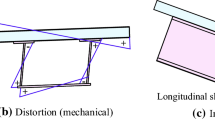Abstract
To accurately control the full-span erection of continuous steel box girder bridges with complex cross-sections and long cantilevers, both the augmented finite element method (A-FEM) and the degenerated plate elements are adopted in this paper. The entire construction process is simulated by the A-FEM with the mesh-separation-based approximation technique, while the degenerated plate elements are constructed based on 3D isoparametric elements, making it suitable for analysis of a thin-walled structure. This method significantly improves computational efficiency by avoiding numerous degrees of freedom (DoFs) when analyzing complex structures. With characteristics of the full-span erection technology, the end-face angle of adjacent girder segments, the preset distance of girder segments from the design position, and the temperature difference are selected as control parameters, and they are calculated through the structural response of each construction stage. Engineering practice shows that the calculation accuracy of A-FEM is verified by field-measured results. It can be applied rapidly and effectively to evaluate the matching state of girder segments and the stress state of bearings as well as the thermal effect during full-span erection.
概要
目的
以港珠澳大桥连续钢箱梁桥为工程背景, 探究适用于模拟全桥全施工阶段且具有高精度的空间有限元方法, 并分析整孔安装的关键施工参数, 从而高效准确地控制大型复杂桥梁结构的整孔安装精度.
创新点
1. 采用基于网格分离的空间强化有限元法, 能够在保证精度的同时简化复杂结构的网格剖分问题, 且适用于任意边界、构造及荷载的空间分析. 2. 在三维实体单元的基础上引入退化板单元, 并对不同物理单元的本构关系矩阵进行修正, 使其适用于薄壁结构分析. 3. 精确计算施工控制参数, 以有效地指导连续钢箱梁的整孔安装过程.
方法
1. 采用空间强化有限元法, 并引入退化板单元, 对连续钢箱梁桥进行全桥全施工阶段分析. 2. 基于结构响应, 计算相邻节段间的端面转角、节段预偏距和温差效应等关键参数以控制整孔安装施工精度, 并与传统有限元法及工程实测数据进行对比验证.
结论
1. 相较于传统有限元法, 空间强化有限元法更高效, 且其精度满足工程要求. 2. 根据各施工阶段的结构响应, 可以精确地控制梁段高程, 以及识别和校核最不利荷载位置. 3. 精确地控制相邻节段在无应力状态下的端部转角、梁段预偏距和箱梁顶底板温差等施工参数, 能够使梁段平顺连接, 使最终支座处于正位状态, 并避免温差效应的影响, 从而实现对整孔安装施工的高精度控制.
Similar content being viewed by others
References
Fang XJ, Yang QD, Cox BN, et al., 2011. An augmented cohesive zone element for arbitrary crack coalescence and bifurcation in heterogeneous materials. International Journal for Numerical Methods in Engineering, 88(9):841–861. https://doi.org/10.1002/nme.3200
Huang W, 2007. Design of deck pavement for long-span steel bridges. China Civil Engineering Journal, 40(9):65–77 (in Chinese). https://doi.org/10.15951/j.tmgcxb.2007.09.004
Jung J, Do BC, Yang QD, 2016. Augmented finite-element method for arbitrary cracking and crack interaction in solids under thermo-mechanical loadings. Philosophical Transactions of the Royal Society A: Mathematical, Physical and Engineering Sciences, 374(2071): 20150282. https://doi.org/10.1098/rsta.2015.0282
Lee KM, Cho HN, Cha CJ, 2006. Life-cycle cost-effective optimum design of steel bridges considering environmental stressors. Engineering Structures, 28(9):1252–1265. https://doi.org/10.1016/j.engstruct.2005.12.008
Ling DS, Yang QD, Cox B, 2009. An augmented finite element method for modeling arbitrary discontinuities in composite materials. International Journal of Fracture, 156(1):53–73. https://doi.org/10.1007/s10704-009-9347-2
Ling DS, Tu FB, Bu LF, 2012. Enhanced finite element analysis of progressive failure of slopes based on cohesive zone model. Chinese Journal of Geotechnical Engineering, 34(8):1387–1393 (in Chinese).
Ling DS, Bu LF, Tu FB, et al., 2014. A finite element method with mesh-separation-based approximation technique and its application in modeling crack propagation with adaptive mesh refinement. International Journal for Numerical Methods in Engineering, 99(7):487–521. https://doi.org/10.1002/nme.4689
Liu W, Yang QD, Mohammadizadeh S, et al., 2013. An accurate and efficient augmented finite element method for arbitrary crack interactions. Journal of Applied Mechanics, 80(4):041033. https://doi.org/10.1115/1.4007970
Liu Y, Yang CX, Tan ZC, 2017. Hybrid element-based virtual distortion method for finite element model updating of bridges with wide-box girders. Engineering Structures, 143:558–570. https://doi.org/10.1016/j.engstruct.2017.04.030
MOT (Ministry of Transport of the People’s Republic of China), 2015. Specifications for Design of Highway Steel Bridges, JTG D64-2015. National Standards of the People’s Republic of China (in Chinese).
Naderi M, Jung J, Yang QD, 2016. A three dimensional augmented finite element for modeling arbitrary cracking in solids. International Journal of Fracture, 197(2):147–168. https://doi.org/10.1007/s10704-016-0072-3
Nguyen TT, Kim NI, Lee J, 2016. Analysis of thin-walled open-section beams with functionally graded materials. Composite Structures, 138:75–83. https://doi.org/10.1016/j.compstruct.2015.11.052
Prokić A, 1993. Thin-walled beams with open and closed cross-sections. Computers & Structures, 47(6):1065–1070. https://doi.org/10.1016/0045-7949(93)90310-A
Razaqpur AG, Li HG, 1991. Thin-walled multicell box-girder finite element. Journal of Structural Engineering, 117(10):2953–2971. https://doi.org/10.1061/(asce)0733-9445(1991)117:10(2953)
Sapountzakis EJ, Dikaros IC, 2019. Advanced 3-D beam element including warping and distortional effects for the analysis of spatial framed structures. Engineering Structures, 188:147–164. https://doi.org/10.1016/j.engstruct.2019.03.006
Su QK, Xie HB, 2016. Summary of steel bridge construction of Hong Kong-Zhuhai-Macao Bridge. China Journal of Highway and Transport, 29(12):1–9 (in Chinese). https://doi.org/10.19721/jxnki.1001-7372.2016.12.001
Thang DD, Koo MS, Hameed A, 2009. Optimum cost design of steel box-girder by varying plate thickness. KSCE Journal of Civil Engineering, 13(1):31–37. https://doi.org/10.1007/s12205-009-0031-x
Vu QV, Thai DK, Kim SE, 2018. Effect of intermediate diaphragms on the load-carrying capacity of steel-concrete composite box girder bridges. Thin-Walled Structures, 122:230–241. https://doi.org/10.1016/j.tws.2017.10.024
Wu YP, Zhu YL, Lai YM, et al., 2002. Analysis of shear lag and shear deformation effects in laminated composite box beams under bending loads. Composite Structures, 55(2): 147–156. https://doi.org/10.1016/S0263-8223(01)00138-6
Wu GF, Xu H, 2005. Theoretical and experimental study on shear lag effect of partially cable-stayed bridge. Journal of Zhejiang University-SCIENCE, 6A(8):875–877. https://doi.org/10.1631/jzus.2005.A0875
Author information
Authors and Affiliations
Contributions
Jin-feng WANG designed the research. Tian-mei WU processed the corresponding data and wrote the first draft of the manuscript. Jin-feng WANG, Jiang-tao ZHANG, and Hua-wei XIANG helped to organize the manuscript. Jin-feng WANG and Rong-qiao XU revised and edited the final version.
Corresponding author
Additional information
Conflict of interest
Jin-feng WANG, Tian-mei WU, Jiang-tao ZHANG, Hua-wei XIANG, and Rong-qiao XU declare that they have no conflict of interest.
Project supported by the National Natural Science Foundation of China (Nos. 51578496 and 51878603) and the Zhejiang Provincial Natural Science Foundation of China (No. LZ16E080001)
Rights and permissions
About this article
Cite this article
Wang, Jf., Wu, Tm., Zhang, Jt. et al. Refined analysis and construction parameter calculation for full-span erection of the continuous steel box girder bridge with long cantilevers. J. Zhejiang Univ. Sci. A 21, 268–279 (2020). https://doi.org/10.1631/jzus.A1900322
Received:
Accepted:
Published:
Issue Date:
DOI: https://doi.org/10.1631/jzus.A1900322
Key words
- Continuous steel box girder bridges
- Full-span erection
- Augmented finite element method (A-FEM)
- Construction control
- Construction parameter calculation




